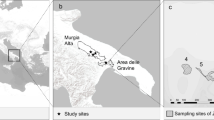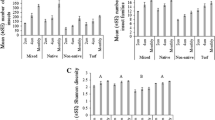Abstract
Habitat degradation is one of the greatest threats to biodiversity worldwide and the main contributor to the decline of many carnivorous plant species. For carnivorous plants in the southeastern United States, including many Pinguicula species (butterwort, Lentibulariaceae), degradation via altered fire regime has been implicated in their decline. Despite this decline, limited empirical research has been conducted examining the influence of habitat structural changes (through natural succession or human management) on reproduction and prey capture by carnivorous plants. The objectives of our study were to compare reproduction and prey capture for Pinguicula lutea (yellow butterwort) in habitats with different vegetation structures in the Florida Panhandle, where differences were largely due to management history. Pinguicula lutea is a self-compatible carnivorous plant that inhabits fire-dependent longleaf pine savannas of the southeastern United States and is threatened in the state of Florida. In 2014 and 2015, 13 sites were identified occupying three different habitat structures: maintained (intermittently mowed), grassy (dominated by Aristida stricta var. beyrichiana), and woody (encroachment by Hypericum and Ilex). Reproductive output was determined by assessing fruit set and ovule fertilization rate at each site. Additionally, prey availability and prey capture were assessed at each habitat site. In general, there were no differences in either measure of reproduction across habitat structure types. There were differences in prey abundance of Collembola, Diptera, and total arthropods both in terms of availability and capture. Total arthropod availability and prey capture were lowest in grassy sites compared to maintained habitat sites and woody habitat sites. Microclimatic conditions associated with each habitat structure and leaf morphology or physiology could explain the observed arthropod abundance and prey capture patterns. This study is the first ecological assessment of plant–insect interactions for Pinguicula species of the southeastern US and highlights the importance of habitat quality and management for this understudied group of carnivorous plants.




Similar content being viewed by others
References
Adlassnig W, Lendl T, Peroutka M, Lang I (2010) Deadly glue—adhesive traps of carnivorous plants. In: von Byern J, Grunwald I (eds) Biological adhesive systems. Springer, Wien, pp 15–28
Adler PH, Malmqvist B (2004) Predation on black flies (Diptera: Simuliidae) by the carnivorous plant Pinguicula vulgaris (Lentibulariaceae) in northern Sweden. Entomol Fennica 15:124–128
Alcalá RE, Domínguez CA (2003) Patterns of prey capture and prey availability among populations of the carnivorous plant Pinguicula moranensis (Lentibulariaceae) along an environmental gradient. Am J Bot 90:1341–1348
Alcalá RE, Mariano NA, Osuna F, Abarca CA (2010) An experimental test of the defensive role of sticky traps in the carnivorous plant Pinguicula moranensis (Lentibulariaceae). Oikos 119:891–895
Antor RJ, García MB (1994) Prey capture by a carnivorous plant with hanging adhesive traps Pinguicula longifolia. Am Midl Nat 131:128–135
Bates D, Maechler M, Bolker B, Walker S (2015) Fitting linear mixed-effects models using lme4. J Stat Softw 67:1–48
Chi K, Molano-Flores B (2015) Habitat degradation disrupts plant-pollinator interactions for a rare, self-compatible prairie species. Plant Ecol 216:1275–1283
Fleischmann A (2016a) Pinguicula flowers with pollen imitations close at night—some observations on butterwort flower biology. Carniv Plant Newsl 45:84–92
Fleischmann A (2016b) Olfactory prey attraction in Drosera? Carniv Plant Newsl 45:19–25
García MB, Antor RJ, Villar L (1994) Phenomorphology and reproductive biology of Pinguicula longifolia Ramond ex DC. subsp. longifolia (Lentibulariaceae), a carnivorous endemic plant of the Pyrenees. Acta Bot Gallica 141:343–349
Gibson TC (1991) Differential escape of insects from carnivorous plant traps. Am Midl Nat 125:55–62
Gluch O (2005) Pinguicula species (Lentibulariaceae) from the southeastern United States: observations of different habitats in Florida. Acta Bot Gallica 152:197–204
Godfrey RK, Stripling HL (1961) A synopsis of Pinguicula (Lentibulariaceae) in the Southeastern United States. Am Midl Nat 66:395–409
Gulledge KJ, Johnson AF, Schultz GE (2011) Rare plant survey of Chassahowitzka Wildlife Management Area, Hernando County, Florida. Florida Fish and Wildlife Conservation Commission Technical Report. Florida Natural Areas Inventory, Tallahassee, FL
Harder R, Zemlin I (1968) Blutenbildung von Pinguicula lusitanica in vitro durch Futterung mit Pollen. Planta 78:72–78
Hermann SM (1995) Status and management of Florida’s carnivorous plant communities. Florida Game and Fresh Water Fish Commission Project Report
Herrera CM (1995) Microclimate and individual variation in pollinators: flowering plants are more than their flowers. Ecology 76:1516–1524
Heslop-Harrison Y, Heslop-Harrison J (1981) The digestive glands of Pinguicula: structure and cytochemistry. Ann Bot 47:293–319
Heslop-Harrison Y, Knox RB (1971) A cytochemical study of the leaf-gland enzymes of insectivorous plants of the genus Pinguicula. Planta 96:183–211
Horner JD, Steele JC, Underwood CA, Lingamfelter D (2012) Age-related changes in characteristics and prey capture of seasonal cohorts of Sarracenia alata pitchers. Am Midl Naturalist 167:13–27
Horner JD, Płachno BJ, Bauer U, Di Giusto B (2018) Attraction of prey. In: Ellison AM, Adamec L (eds) Carnivorous plants: physiology, ecology, and evolution. Oxford University Press, Oxford, pp 157–166
Jennings DE, Rohr JR (2011) A review of the conservation threats to carnivorous plants. Biol Conserv 144:1356–1363
Joel DM, Juniper BE, Dafni A (1985) Ultraviolet patterns in the traps of carnivorous plants. New Phytol 101:585–593
Karlsson PS, Nordell KO, Eirefelt S, Svensson A (1987) Trapping efficiency of three carnivorous Pinguicula species. Oecologia 73:518–521
Karlsson PS, Thorén LM, Hanslin HM (1994) Prey capture by three Pinguicula species in a subarctic environment. Oecologia 99:188–193
Kesler HC, Trusty JL, Hermann SM, Guyer C (2008) Demographic responses of Pinguicula ionantha to prescribed fire: a regression-design LTRE approach. Oecologia 156:545–557
Legendre L (2000) The genus Pinguicula L. (Lentibulariaceae): an overview. Acta Bot Gallica 147:77–95
Lenth RV (2016) Least-squares means: the R package lsmeans. J Stat Softw 69:1–33
Louda SM, Rodman JE (1996) Insect herbivory as a major factor in the shade distribution of a native crucifer (Cardamine cordifolia A. Gray, bittercress). J Ecol 84:229–237
McKinney AM, Goodell K (2010) Shading by invasive shrub reduces seed production and pollinator services in a native herb. Biol Invasions 12:2751–2763
Menges ES, Kimmich J (1996) Microhabitat and time since fire: effects on demography of Eryngium cunefolium (Apiaceae), a Florida scrub endemic plant. Am J Bot 83:185–191
Molano-Flores B, Primer S, Annis J, Feist MAE, Coons J, Digges R (2018) Reproductive ecology of three rare North American Pinguicula species. Plant Spec Biol 33:129–139
Molau U (1993) Reproductive ecology of the three Nordic Pinguicula species (Lentibulariaceae). Nordic J Bot 13:149–157
Murza GL, Davis AR (2005) Flowering phenology and reproductive biology of Drosera anglica (Droseraceae). Bot J Linn Soc 147:417–426
Noss R, Platt WJ, Sorrie BA, Weakley AS, Means DB, Costanza J, Peet RK (2015) How global biodiversity hotspots may go unrecognized: lessons from the North American Coastal Plain. Divers Distrib 21:236–244
Pavón NP, Contreras-Ramos A, Islas-Perusquía Y (2011) Diversity of arthropods preyed upon by the carnivorous plant Pinguicula moranensis (Lentibulariaceae) in the temperate forest of central Mexico. Southwest Nat 56:78–82
Primer S (2016) The effect of habitat structure on reproduction and prey capture of a rare carnivorous plant, Pinguicula lutea. MS Thesis, University of Illinois at Urbana-Champaign
R Core Team (2015) R: a language and environment for statistical computing. R Foundation for Statistical Computing, Vienna, Austria. http://www.R-project.org/
Schneider CA, Rasband WS, Eliceiri KW (2012) NIH Image to ImageJ: 25 years of image analysis. Nat Methods 9:671–675
Schnell DE (2002) Carnivorous plants of the United States and Canada, 2nd edn. Timber Press, Portland, 468 pp
Tews J, Brose U, Grimm V, Tielbörger K, Wichmann MC, Schwager M, Jeltsch F (2004) Animal species diversity driven by habitat heterogeneity/diversity: the importance of keystone structures. J Biogeogr 31:79–92
Van Lear DH, Carroll WD, Kapeluck PR, Johnson R (2005) History and restoration of the longleaf pine-grassland ecosystem: implications for species at risk. For Ecol Manag 211:150–165
Wunderlin RP, Hansen BF, Franck AR, Essig FB (2018) Atlas of Florida plants (http://florida.plantatlas.usf.edu/).[Landry SM and Campbell KN (application development), USF Water Institute]. Institute for Systematic Botany, University of South Florida, Tampa
Zamora R (1990) The feeding ecology of a carnivorous plant (Pinguicula nevadense): prey analysis and capture constraints. Oecologia 84:376–379
Zamora R (1995) The trapping success of a carnivorous plant (Pinguicula vallisneriifolia): the cumulative effects of availability, attraction, retention, and robbery or prey. Oikos 73:309–322
Zamora R (1999) Conditional outcomes of interactions: the pollinator-prey conflict of an insectivorous plant. Ecology 80:786–795
Zamora R, Gómez JM, Hódar JA (1998) Fitness responses of a carnivorous plant in contrasting ecological scenarios. Ecology 79:1630–1644
Acknowledgements
We would like to thank the following individuals and organizations that made this project possible: Jean Mengelkoch (Illinois Natural History Survey); Mary Ann Feist (University of Wisconsin-Madison); Jenna Annis (Eastern Illinois University); Michael R. Jenkins and David Morse (Florida Forest Service); Vivian Negron-Ortiz (U.S. Fish and Wildlife Service); Faye Winters (U.S. Bureau of Land Management); Cheryl Peterson (Bok Tower Gardens); Jim Moyers (St. Joe Company); Wendy Jones (Tyndall Air Force Base); Caroline George (Tyndall Air Force Base/U.S. Fish and Wildlife Service); Dylan Shoemaker, Barry Townsend, Sandra Chafin, Allix North, Lisa Duglecki, Max and Pat Prucell, and Dave and Joy Peterson (St. Joseph Bay State Buffer Preserve); and Brittany Phillips (Apalachicola National Forest). In addition, thanks to the following citizen scientists: Melissa Primer, Bill and Marcia Booth, Patricia Stampe, and Robin Kennedy. This project was funded by a grant from Florida Forest Service and other sources of funding and/or in-kind contributions (U.S. Fish and Wildlife Service, U.S. Bureau of Land Management, Bok Tower Gardens, Eastern Illinois University, University of Illinois, and Illinois Natural History Survey).
Funding
Funding was provided by Florida Forest Service.
Author information
Authors and Affiliations
Corresponding author
Additional information
Handling Editor: Stanislav Gorb.
Electronic supplementary material
Below is the link to the electronic supplementary material.
Rights and permissions
About this article
Cite this article
Primer, S., Molano-Flores, B., Zaya, D.N. et al. Effect of habitat structure on reproduction and prey capture of a rare carnivorous plant, Pinguicula lutea. Arthropod-Plant Interactions 12, 671–683 (2018). https://doi.org/10.1007/s11829-018-9632-y
Received:
Accepted:
Published:
Issue Date:
DOI: https://doi.org/10.1007/s11829-018-9632-y




